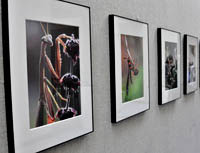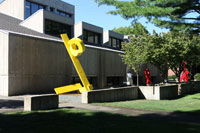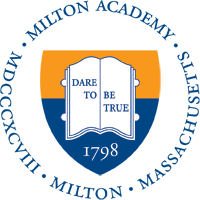Arts in the News
Dr. Eyster Fuses Biology and Art as she “Looks Closely”
 Linde Eyster enjoys looking closely at things—as a scientist, as a teacher, and as a photographer. For the past few years, she focused on the natural environment in her backyard garden, photographing a range of organisms with a macro lens. The result is a stunning, colorful collection on exhibition in Pieh Commons.
Linde Eyster enjoys looking closely at things—as a scientist, as a teacher, and as a photographer. For the past few years, she focused on the natural environment in her backyard garden, photographing a range of organisms with a macro lens. The result is a stunning, colorful collection on exhibition in Pieh Commons.
“I wanted the photos to tell biological stories,” says Linde, who has taught a variety of life science courses at Milton since 1990. “So, you’re not just looking at a photo of two ants. You are looking at a biological process. The ants are on a stem guiding the tiny aphids up and down, because the ants are dependent on the aphids for their nourishment.”
Linde shot all the images outside in natural light, with the subjects in their usual patterns and environment. The project grew out of a cross-curricular biodiversity assignment she assigned her Advanced Biology students, who were required to find and photograph a dozen different invertebrates on campus or near their homes.
“I did the assignment myself to estimate how long it would take to accomplish, and the project reawakened my love of photographing little things,” says Linde. “Even without a camera in hand, I love the surprises of looking closely in the leaves and stems in my small garden where I witness both amazing organisms and fascinating animal behaviors.”
Linde’s friend and fellow faculty member Bryan Cheney—a photographer and member of the visual arts department—answered her photography questions and helped her sort through hundreds of photos to select the ones to exhibit.
Linde’s interest in photography began as a child, when she occasionally converted the bathroom into a darkroom to develop her prints. For research toward her master’s degree, she took her first close-up photographs to document the colors of nudibranchs (sea slugs), which fade quickly when the organisms are placed into preservatives. During her doctoral research on embryonic shell formation at Northeastern University, she spent many hours photographing subcellular structures with transmission electron microscopes, followed by hours of printing thousands of black and white images of cells and cell parts. Many of these images were published in her scientific papers.
“Without realizing it, I was learning skills through my microscope photography, such as composing the shot, finding the right angle, and cropping to focus on the elements you want,” says Linde.
Looking Closely: My Garden 2011–2014 opens this Friday at recess and will be on exhibit until the end of October.
AMC Rewards Imagination With New Functionality
 For the first time, at least in “modern” history, students can pursue any and all of Milton’s visual arts programs in one building, the Art and Media Center. This summer, changes that will not strike some as dramatic, have nevertheless prepared all three levels of the AMC for unparalleled opportunities and collaborations in the arts. Ian Torney, visual arts chair, used the relocation of sculpture, ceramics and woodworking from Robert Saltonstall as a chance to rethink how spaces are outfitted and aligned, not only for today’s world of arts, but anticipating how the field will develop over time.
For the first time, at least in “modern” history, students can pursue any and all of Milton’s visual arts programs in one building, the Art and Media Center. This summer, changes that will not strike some as dramatic, have nevertheless prepared all three levels of the AMC for unparalleled opportunities and collaborations in the arts. Ian Torney, visual arts chair, used the relocation of sculpture, ceramics and woodworking from Robert Saltonstall as a chance to rethink how spaces are outfitted and aligned, not only for today’s world of arts, but anticipating how the field will develop over time.
The two studios on the AMC’s south side are now all dedicated to 3-D art, including sculpture and ceramics. The two north-facing studios will serve drawing, painting and printmaking. All four main level studios are flexible enough to support any studio art foundations course. A new machine tool shop located in the center now connects both banks of studios, making projects of all kinds possible as contemporary art-making blurs the lines between two- and three-dimensional arts. The building’s loading dock now has electrical power to accommodate outdoor welding, and electrical outlets hang from the ceilings in various locations throughout all the studios. New Smartboards in all four main level studios support teaching.
On the AMC’s top floor, the former Weld Library has become a technology and design studio; Bryan Cheney (Visual Arts) and Brad Moriarity (Science) teach their new collaborative course in this studio, Creating Form and Space: Architecture and Engineering. A digital imaging MAC lab is located on the west side of the top level, along with a lighting studio for photography. The east side of that level features a MAC moving image lab and viewing studio.
Not to be left out of the action, the AMC lower level now includes an office and work space for Milton’s busy A/V department, and a film and moving image production studio, with a “green screen,” a prerequisite for shots that involve actors and imposed imagery (like the meteorologist broadcasting a weather forecast in front of a relevant map). The AMC lower level also provides dedicated space for robotics and computer engineering projects, in addition to Greely Auditorium, the Nesto Gallery, and photography dark room facilities. Key upgrades to make the building accessible to persons with disabilities have occurred as well.
This upgrade and rework of AMC space looks to maximize capability and functional ease for all types of imaginative projects that students and faculty typically devise. Classrooms are flexible; technology, which “is one of the key drivers in visual arts growth,” according to Ian, is ubiquitous. “We haven’t precluded doing more in and for the arts,” he says, “and the enhancements in this building are not only effective today; they look quite deliberately to a future that we regularly work to anticipate.”
Note: RSG vacated spaces now accommodate two classrooms for Milton’s health, fitness and wellness programs, and create needed meeting, office and storage space for Athletics.
